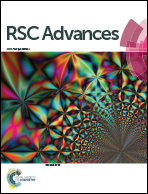One pot microwave-assisted synthesis of Ag decorated yolk@shell structured TiO2 microspheres†
Abstract
A facile and economical one-pot microwave-assisted approach for the synthesis of Ag decorated yolk@shell structured TiO2 microspheres (Ag-TS) is reported. The rapid and uniform microwave heating could reduce the reaction time to 30 min, an order of magnitude shorter than that of conventional methods. The characterization data confirmed that the resultant mesoporous structured Ag-TS were highly uniform in size with an average diameter of ∼0.5 μm, which was constructed by small anatase TiO2 nanoparticles, along with Ag nanoparticles ranging from 10 to 50 nm homogeneously dispersed on the microspheres. Nitrogen adsorption–desorption measurement revealed that all the Ag-TS samples had high specific surface areas (>100 m2 g−1) and abundant mesoporous structures. The growth model of Ag-TS was proposed based on a series of contrast experiments, the unique selective heating of reaction solvent (deionized water and ethanol) by the microwave method was found to be critical. At the initial stage, amorphous solid microspheres were formed by heating of ethanol molecules through absorbing microwave energy due to the better microwave absorbing performance. Then water molecules were heated by the microwave irradiation, the crystallization of anatase TiO2 on the surface of the solid microspheres started, followed by the Ti species diffusing spontaneously towards the outer surface of the solid microspheres and leading to the formation of the outer shell due to the Ostwald ripening process. Finally, water continuously diffused through the outer shell and guided the subsequent crystallization of anatase TiO2, resulting in the formation of the core. Besides, the application of Ag-TS for the removal of water contaminants including toxic heavy metal hexavalent chromium (Cr(VI)) ions and organic dye methylene blue (MB) were also evaluated.


 Please wait while we load your content...
Please wait while we load your content...